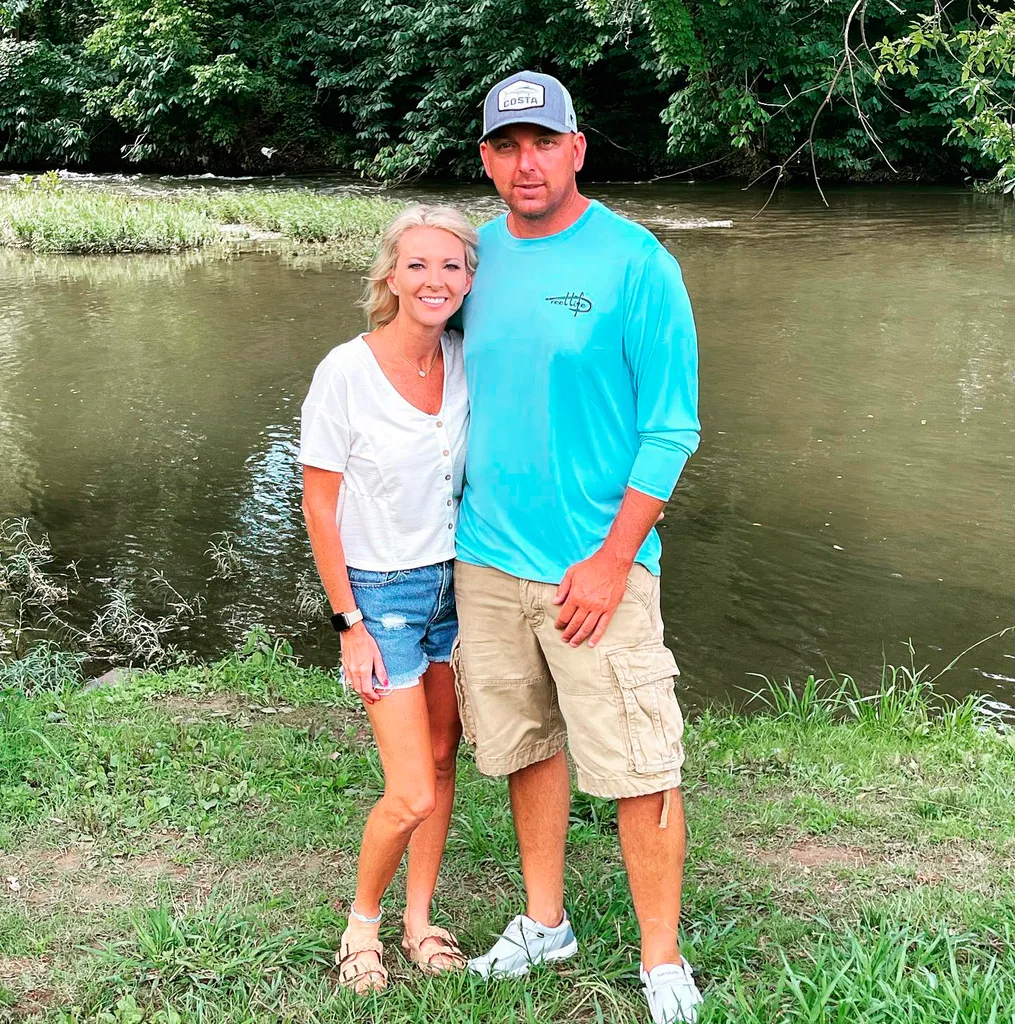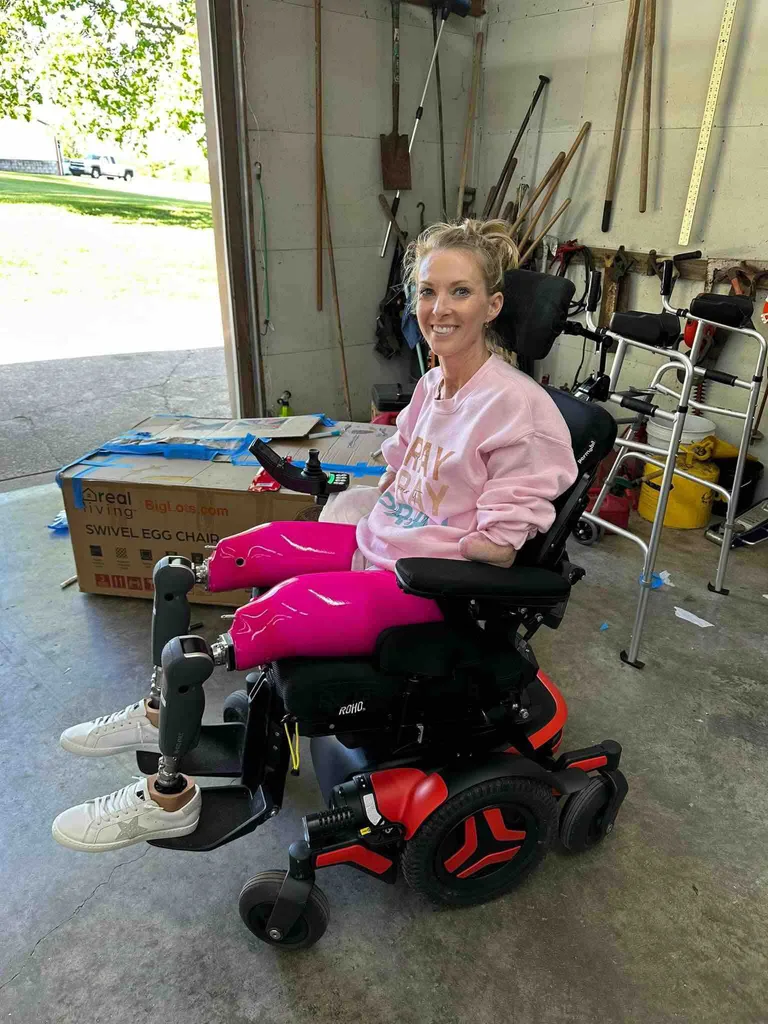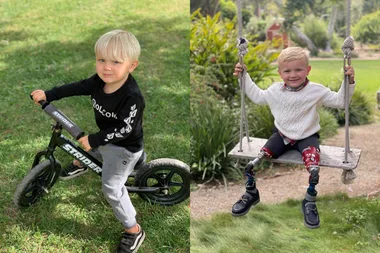- When Lucinda Mullins, 41, went in for a routine kidney stone surgery, she never expected to be fighting for her life.
- Follow up scans showed one of the tiny kidney stones had been left behind and become infected.
- By now Lucinda was battling an aggressive infection that was quickly spreading through her body.
- To save her life, docs had to amputate her arms and legs.
Here Lucinda tells her story in her own words
Packing our bags into the campervan, we hit the road for a family getaway.
My hubby DJ, then 42, drove and our boys Teegan, then 12, and Easton, seven, sang along to the radio.
Arriving at our favourite camping spot by a lake, we unpacked for the week.
We were getting set to take our boat out on the water when I felt a familiar sharp pain spread across my lower back.
Not again, I thought.
A few months earlier, doctors found I had 14 kidney stones.
They were so tiny, docs said they’d likely pass on their own, and recommended I take paracetamol and drink lots of water.
So when I felt the pain strike again, I took some meds and went about my day.

But when the pain persisted for the rest of the week, I realised something was wrong.
A nurse, I knew not to put off getting help.
After we returned home, I went to see my GP who ordered a CAT scan.
Results showed I still had several kidney stones and one pesky stone was stuck in my ureter – the duct from the kidney – which is why I’d been in so much pain.
‘I must have a cold.’
The next day in hospital, docs inserted a stent in my urethra – the tube from the bladder – to allow the stones in my left kidney, which had the most stones, to pass through smoothly.
At home later that day, I was a little uncomfortable, but otherwise my usual self.
After three days bed rest, with instruction from my doctor, I removed the stent, using a string attached at the end of it.
A few months later, in December last year, I had the same procedure on my right kidney.

Removing the stent, just like the first time, everything felt fine.
But the next morning, I woke with a fever and scratchy throat.
I must have a cold, I thought.
But within a few hours, my symptoms escalated to severe back pain, and I couldn’t keep any food or water down.
‘Lucinda will be lucky to survive the night.’
I spent the night running to the toilet and the following morning, DJ found me collapsed on the bathroom floor.
As I drifted in and out of consciousness, he phoned my mum Reba, to watch the kids while he drove me to Emergency.
There, a scan showed one of the tiny kidney stones had been left behind and become infected.
As my condition worsened, I was intubated and transferred to a bigger hospital.

A risk with kidney stones is a kidney infection which can lead to sepsis. Sepsis is a life-threatening condition that can develop quickly if an infection, such as a kidney infection, spreads through the body. When left untreated, sepsis can cause the immune system to overact, leading to widespread inflammation. This inflammation can disrupt blood flow, particularly to the limbs causing tissue damage. In severe cases, sepsis can progress to septic shock, where blood pressure drops critically low, and the risk of losing limbs increases. Understanding how sepsis can start from something as minor as a kidney stone infection is crucial for early detection and treatment to prevent limb loss.
How can a kidney stone cause sepsis?
The next thing I knew, I woke up in hospital with DJ by my side.
‘You had me so worried, sweetheart,’ he said, explaining I’d been in a coma for seven days.
I was shocked to hear doctors discovered I was in septic shock, causing my organs to shut down.
‘Lucinda will be lucky to survive the night,’ they’d warned him.
‘If this is the sacrifice I had to make to be alive. I’m okay with it.’
Surgeons tried to remove the lodged stone, but it was surrounded by so much infected tissue they couldn’t reach it.
So they inserted another stent in the hope it’d pass on its own.
Who knew they could be so deadly, I thought.
Over the next few days, my organ function started to improve, but purple blotches had broken out on my hands and legs.
As they turned darker, a doctor had devastating news.

‘We’re going to have to amputate your legs and arms,’ he said gently.
‘I can’t believe this is happening,’ I sobbed to DJ.
But I knew if I wanted to see my boys grow up, I had no choice.
It was life over limb!
‘When are you coming home?’
The next morning, both my legs were removed above the knee.
If this is the sacrifice I had to make to be alive. I’m okay with it, I decided.
After two weeks, once the infection cleared, I was back in theatre to have the kidney stone removed.
DJ’s mum, Janice, brought the boys to see me often.
She and my mum had been minding them.

Kidney stones are hard deposits made of minerals and salts that form inside your kidneys. Broken down into four types, calcium oxalate, uric acid, struvite, and cystine, after thy are formed, the stone may stay in the kidney or travel down the urinary tract into the ureter. Common symptoms include severe pain in the lower back, blood in your urine, nausea, vomiting, fever and chills, or urine that smells bad or looks cloudy. In most cases, tiny stones move out of the body in the urine without causing too much pain. However, large stones that don’t move cause a back-up of urine in the kidney, ureter, bladder, or urethra. This can lead to infection and be very painful. Kidney stones may be treated with shockwave lithotripsy, ureteroscopy, percutaneous nephrolithotomy or nephrolithotripsy.
What causes kidney stones?
‘When are you coming home?’ Easton asked after every visit.
‘When Mummy is feeling better and all the sick parts are gone,’ I explained, trying to stay positive.
Hoping to save my elbows, docs waited for the blood circulation to return and skin to grow, before amputating my lower arms two months later, in February.
Then I began a month of daily physio to learn to navigate life without limbs, focusing on core and upper extremity strength training.
‘You’ve got this, mum!’
DJ built a ramp for my powered wheelchair that I could operate with my elbow, and I was home two weeks later.
I relied on DJ and Teegan to move me to and from my chair.
Once my amputation sites were healed, I was fitted with a pair of hot pink sparkly prosthetics.
And within a few weeks I was back on my feet with the support of a walker.
Taking my first wobbly steps, I was determined to master my new legs.

‘You’ve got this, Mum!’ my kids cheered.
Last month, I received hook prosthetics – the hook opens and closes by pulling a cable attached to my right shoulder.
And in a few months’ time I’ll be trading in my hooks for prosthetic hands.
While some days are harder than others, my boys know just how to keep the smile on my face.
My rock, DJ, cooks and cleans, and has even learned to do my hair and make-up.
He works most days from home and my mum is always around too.
Teegan, now 13, and Easton, eight, are my biggest supporters.
‘We love you,’ they remind me every day.
I couldn’t have made it without the love of my family.
 Supplied
Supplied


